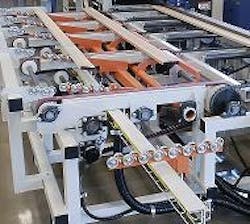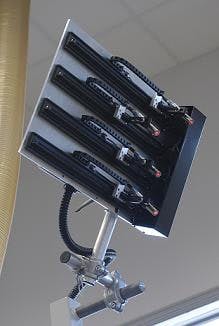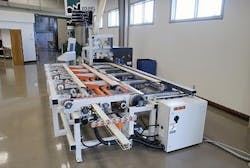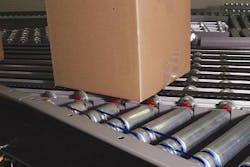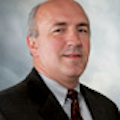Control Logic's ValuRip Plus and TGW-Ermanco's Turbo Sorter Earn 2009 Innovator Awards
Each year, we select the most innovative applications of machine automation and showcase them in our annual Innovator Awards. This year, six other innovative companies designed and built machines that merit recognition and a more thorough explanation of the creative use of automation and technology that makes them different. While each one of these innovators' machines is equally compelling, we'll put the question to you, as to which one you'd like to learn about most.
Innovation comes in waves and sometimes rips through an industry. That's exactly what happened with the two winners of the 2009 Control Design Innovator Awards. Each is a game changer that takes existing controls and automation technology and brings an entirely new machine category to the industry it serves. First, Control Logic was able to reinvent itself after all of its traditional customers headed east. By combining PC and PLC control, Control Logic was able to bring a modified version of its previous offerings to the lumber and mouldings market. Our second winner, TGW-Ermanco used local logic to create a more-efficient and less-expensive distribution system solution.
RIP, Traditional Ripsaw: Control Logic's ValuRip Plus
What Aiken found was that almost 30% of Control Logic's code base was being spent to connect the PC and PLC worlds. "We had to have OPC drivers and all of the hardware and separate programming software," he says. "What attracted us to the Beckhoff platform was we were doing the embedded platform for years. We wanted that with the supportability of a PLC. We reduced our code base by 30%. We've got the beauty of the reliability of an embedded platform. We're using Flash rather than hard drives. I can create a Flash image and ship it to a customer. System integrators and OEMs today have to be able to effectively and remotely diagnose and troubleshoot. As an OEM we have to reduce components and cabling because the success and failure of our solution is based on total cost of ownership."
Where the Teeth Meet the GrainLan McIlvain, operations manager at Alan McIlvain, one of the hardwood and custom moulding distributors Aiken describes, has begun using Control Logic's new solution, the ValuRip Plus, at his company's facility in Marcus Hook, Pa. "We used to have two ripsaws that were manual," he explains. "That's how 90% of the world does it. There was nothing computerized attached to it. It was strictly a saw. This new machine looks at each piece and has a cut list and knows how to get the best board yield manually. On a daily basis, we're ripping about 15,000 board feeds in volume." The old machines would do around 5,000, he says.
"Doing the shape detection and optimizing the board for cutting did not exist for a small cabinet manufacturer," explains Aiken. "They would measure the width at one point on the board and then you'd have to do manual overrides on every board. The first defect a board has is its shape. Most of the systems would measure the width of the board at one point. When you pull a board out of the drying process, in an extreme case, you have a banana. Systems would measure the width of the board at one point and treat the board as a rectangle, so the operator would have to take a measurement."
The ValuRip Plus completely eliminates the need for the saw operator to guess at the cuts he can get out of a board, which in turn reduces a great amount of waste, says McIlvain. "Since we installed the machinery we have seen at least a 5% increase in yield, we are able to process lumber twice as fast, and we have virtually eliminated human error. We have very high-end imported species of lumber. That ends up saving us even more money than we save in labor."
Before the ValuRip Plus, Alan McIlvain was using a manual gang ripsaw run on two shifts and a straight line ripsaw run on one shift. "The same amount of work now gets done on one shift with only three employees versus a total of eight employees before," says McIlvain. "The same person is still running the machine." He's monitoring the process and overrides the computer's decision when he sees a knot or certain other things, he says.
"By measuring the shape of the board properly, now all they have to measure for is cosmetic defects like knots and cracks," explains Aiken (Figure 2). "Our next step with this machine is we'll pull out the discrete sensors so we can get a 3D measurement."
You've Come a Long Way, RipPreviously, the machines produced by Control Logic were traditional combinations of an Allen-Bradley PLC and a separate industrial PC, says Aiken. "Along with that, we created some complexity for the customer because we always had two platforms to connect together—PLC for machine control and the PC for the OI," he explains. "Beckhoff brought us a nice solution because it's one piece of DIN-rail-mounted hardware. We physically shed components. That was a huge advantage in reaching the price points we needed to make the machines inexpensive enough for this market. Our offering from a scanning standpoint, controls and interface standpoint was more expensive than our customers wanted to pay. We got a reduction in cabinet size and cabling, which resulted in a price point reduction."
This measurement couldn't be done without additional hardware before, explains Aiken. "As I/O rates become higher, we're able to do certain measurements across the I/O rather than special function modules," he says. "We had a system in another form that we had, but we had to write custom device drivers in XP. And we had already been down the embedded route."
The Brains Behind the Teeth"Lumber ripping" applies to the process of taking cuts of lumber from rough mills and ripping strips out of the wood at predetermined dimensions. Control Logic rip-optimizing systems measure the shape of the boards to be ripped and detect surface defects. The systems mathematically determine the optimum ripping path for each board of lumber based off these conditions.
Control Logic selected the CX1020 Embedded PC with a 1 GHz Intel Celeron M paired with TwinCat NC PTP for complete automation, axis positioning and controls device management. The CX1020 is connected to a Beckhoff CP6901 control panel with DVI/USB interface as the HMI hardware. For the amplifier, the ValuRip Plus features the Beckhoff AX2003 digital servo drive with EtherCat interface. EtherCat can communicate with up to 100 servo axes in 100 µs. "The CX1020 brought Control Logic software efficiency, scalability and fewer required communication layers," says Aiken. "In addition, the CX1020 features a direct backplane connection to EtherCat I/O terminals. With a single hardware device and TwinCat software, we can now combine the advantages of the PLC's hard real-time and the flexibility to choose programming languages, such as structured text, ladder and function block diagram."
In addition to the obvious controller efficiencies with regard to size and cost, the biggest functionality improvement in the new control system was with I/O update rates, says Aiken. "This was very important to us because we wanted to create a very low-cost 2D shape scanner," he says. This requires a photoelectric array over which the lumber is transported with a high-precision surface. To perform the measurement, Control Logic had to sample the presence of the material at a very high rate—4 KHz—in coordination with encoder sources. "In the past, we couldn't poll the inputs with a PLC at this rate and were forced to perform the task using a PC I/O card and a custom device driver which we developed and maintained," explains Aiken. "So, the great improvement for us is that, with the high-speed performance of both the EtherCat I/O and the CX1020 processing power, we are able to accomplish the scanning task without custom I/O frameworks or delicate in-house software. Even at the 4 KHz update rates, we are only seeing about a 9–15% CPU load."
The Wave of the Future: TGW-Ermanco's Turbo Sorter
In distribution centers around the globe, products that have been ordered by companies and individuals from Australia to Alabama need to be sorted and shipped out. About three years ago, the engineering staff at TGW-Ermanco wanted to design a cost-effective, pop-up wheel conveyor "Traditional pop-up wheel conveyor systems can move about 100 cases/min (cpm)," says Del Deur, director—product development at TGW-Ermanco in Spring Lake, Mich. "We wanted to design our new Turbo sortation system to move up to 200 cpm. In the distribution business, sortation rates can go up to 300/min. That's about the upper limit of a sliding-shoe sorter, the next step up from this system."
Traditional pop-up wheel sorters follow the theory that the more wheels on the conveyor, the faster the cases of product can move through the system, believing that by raising more rows of wheels under the carton, the system has a better chance of grabbing the product and carrying it off the conveyor to its correct destination. However, by raising multiple rows together, the cases have to be spaced further apart, which significantly lowers the number of cartons that can be moved.
The Turbo sorter solves this problem by implementing the patent-pending Wave technology, which raises and lowers each row of wheels individually. The row raises as the leading edge of a carton arrives at the divert point and lowers as the trailing edge is conveyed over the divert wheel row. With just one row of wheels moving at any given time, the cartons can be spaced much closer together.
In order to move each row of wheels as quickly as possible, the TGW-Ermanco engineers needed a local controller at each divert point. "We found that even a programmable logic controller (PLC) with a 10 msec program scan time wasn't fast enough," says Deur. "In order to move the wheels and boxes as fast as our customers demanded, we needed a product that would complete program scans in the 1-to-2-msec range."
Let's Get It Started"The first sensor on the conveyor itself is a bar-code scanner," explains Deur. "Then it's tracked with software and an encoder that tracks the belt movement. The wheels are at the divert point. One row of wheels is raised up 3 in. before the box gets to the row. It's tracked physically with the PAC logic."
TGW-Ermanco looked at a few alternatives. "We did look at whether it's possible to take one overall system controller and get enough speed for this local control, but we were pushing conveyor speeds of 425 ft/min," says Deur. "With the resolution we wanted, we didn't see any controller that would work at that speed. For resolution, you're trying to convert down to an inch or half-inch. Pulses coming in at that resolution get down to the millisecond range. We need a minimum of 6 in. That's enough time to get the wheels up with the pneumatics. But we don't want to add more time for the logic to react."
To help meet the program scan time requirement, the Rockwell Automation ArmorBlock MaXum I/O module with Rockwell Automation DeviceLogix technology was used for each divert point. DeviceLogix technology, which is embedded in the ArmorBlock module's internal miniprocessor, provides the programmable logic without having to loop back through the central PAC, says Deur. DeviceLogix embedded firmware is an extension of basic component functionality that controls outputs and manages status information. As part of the I/O block, it combines inputs and outputs and programmable local logic to determine behavior.
"The central controller does the tracking," explains Deur. "Once a product is scanned and introduced to the sorter, then the PAC takes over. When the carton gets close to a diverter, it informs the diverter control over DeviceNet. That's when the carton is within a few inches of a sensor that's prior to the divert wheels. The sensor is plugged into the ArmorBlock I/O module. That's the trigger. You block that sensor at the same timing window that the main controller says, 'Here's a carton.' Then the diverter takes over. There's a retro-reflective presence sensor just looking for the leading edge of the carton."
A Different Way to CommunicateTGW-Ermanco typically does its remote I/O through Ethernet, but this application called for DeviceNet, says Deur. "We don't use much DeviceNet, but this just happened to come in a DeviceNet format," he says. "If this were in Ethernet, we'd use it as Ethernet. The advantage is we use the flat ribbon cable, which allows us to get power out to these devices. There are six solenoids per divert location, so we do need to get power out to them, and this is done without conduit. A giant distribution center might have 50 divert points. We tend to work with smaller customers, where you probably have 16-24 divert points. In the real large systems, your rates tend to be higher, and that pushes you closer to a sliding-shoe sorter."
Each ArmorBlock MaXum I/O module is connected via DeviceNet to a central Rockwell Automation CompactLogix programmable automation controller (PAC), explains Deur. "When that central controller receives an alert that a box is headed toward a specific divert point, it seamlessly alerts the ArmorBlock MaXum I/O module," he says. "The programmable logic necessary to move the row of wheels up and down to divert the box can be completed locally without having to loop back through the central PAC."
By carrying out logic control at the divert point rather than at the centralized master PAC, the time for an input to be sensed and an output to be actuated decreases significantly (Figure 4). TGW-Ermanco engineers were able to complete the necessary program scans in less than 2 msec.
J.J. Phelan, PE, chief operating officer at TriFactor, a material-handling system integrator in Lakeland, Fla., installed a Turbo sorter at a distribution center for a leather goods retailer. "It's a 579-ft shipping sorter located on a mezzanine above the shipping dock doors," he explains. "Cartons in average length of 22 in. at a rate of 60 cartons/min are inducted into the sorter. Prior to induction, cartons are merged with the recirculation line with a two-to-one combiner. There are 18 existing or active divert lanes and two future divert lanes that the sorter tracks all cartons on and diverts to the right side appropriately. Once diverted, a confirmation signal is returned to ensure tracking accuracy. Also, each shipping line has a full-lane photo eye that tells the sorter to skip diverting to that lane and recirculate product until the full-lane photo eye is cleared."
The throughput rate of the Turbo sorter fits between those of the more-expensive shoe sorter and the lower-speed pivot wheel, pop-up wheel or urethane belt transfer, explains Phelan. "Before the Turbo sorter, customers had to make a sacrifice, either spend more money for a high-speed sorter in preparation for future growth, even though current demands don't require the rates, or spend less money but limit the growth potential and future throughput requirements. The Turbo sorter allows a customer to spend the proper amount of money on a sorter that can accommodate current and foreseeable future needs."
The Turbo sorter also was implemented in late 2008 in Petco's distribution center in Braselton, Ga. "It was an application we were looking for," says Mike Fernstrom, director of distribution operations at Petco. "This one had the engineering and the performance expectations. A sliding-shoe sorter could have done the job, but the cost would have been higher, and in my other experiences with shoe sorters, there have been issues with missed diverts."
The Wave technology gave Petco the confidence to meet expectations and eliminate missed diverts. "We're considering the Turbo sorter for other Petco facilities now," says Fernstrom. "We've got one merge operator at the facility, but the sorter runs itself. It was installed and ready to go in less than 45 days."
About the Author
Mike Bacidore
Editor in Chief
Mike Bacidore is chief editor of Control Design and has been an integral part of the Endeavor Business Media editorial team since 2007. Previously, he was editorial director at Hughes Communications and a portfolio manager of the human resources and labor law areas at Wolters Kluwer. Bacidore holds a BA from the University of Illinois and an MBA from Lake Forest Graduate School of Management. He is an award-winning columnist, earning multiple regional and national awards from the American Society of Business Publication Editors. He may be reached at [email protected]

Leaders relevant to this article:
